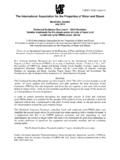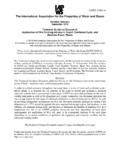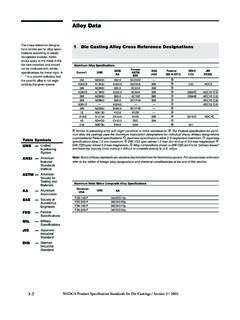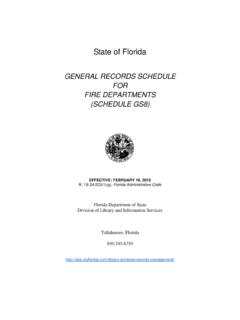Transcription of Obsolete IAPWS Recommendations
1 March 2005. Obsolete IAPWS Recommendations 1) Introduction. The International Association for the properties of water and steam ( IAPWS ) issues Recommendations for various thermophysical properties of water and aqueous systems. The current documents may be found on the IAPWS website, , in the Releases and Guidelines section. On occasion, there is interest in Obsolete Recommendations , perhaps because of a reference in an old paper or because existing software has made use of an old formulation. The purpose of this document is to give some basic information about Obsolete Recommendations adopted in the past by IAPWS (and its predecessor organizations: International steam -Table Conferences, International Conferences on the properties of steam , the International Organization for the properties of steam , and the International Association for the properties of steam [IAPS]).
2 Where possible, references are given for places where the Obsolete items are documented. 2) Skeleton Tables. Efforts to produce international agreement on values for the properties of water and steam began with International steam -Table Conferences held in 1929, 1930, and 1934. The 1934 meeting produced agreement on a set of skeleton tables. These were tables of pressure, enthalpy and volume for the saturated vapor and liquid and of specific enthalpy and specific volume on a coarse grid of temperature-pressure points in the one-phase regions. Estimated uncertainties were given. These original skeleton tables, which had an influence on several widely used sets of steam tables, may be found in several references [1-4].
3 After World War II, new power plants were being designed to reach higher temperatures and pressures than ever before, and it became clear that the 1934 skeleton tables were no longer adequate. In addition, new data offered the opportunity for improved accuracy. An international effort resulted in new skeleton tables that were approved in 1963; these tables extended to 100 MPa and 800 C. The 1963 skeleton tables are reproduced in a number of different steam Tables books [5-13] and at least one journal article [14]. Work continued to improve the state of knowledge, and a concerted effort resulted in new skeleton tables adopted in 1985.
4 These were revised in 1994 to reflect the new International Temperature Scale of 1990. The original 1985 tables may be found in a journal article [15]; the 1994 revision has been published [16] and is available as a PDF. file [17]. As computers were increasingly used for property calculations, and as estimates of uncertainty became available for equation-based formulations, the value of the skeleton tables diminished. The last skeleton tables were withdrawn by IAPWS in 2003; IAPWS . Recommendations are now exclusively equation-based. 3) Obsolete Industrial Formulations. As computers became more widely used in industry, it became desirable to represent water and steam properties by equations rather than tables and charts.
5 The International Formulation Committee was established at the 6th International Conference on the properties of steam to create formulas for the thermodynamic properties of water and steam consistent with the 1963 Skeleton Tables. A. preliminary formulation (IFC-66) was adopted in 1966, followed a year later by a revision known as the IFC-67 formulation, which remained in use for many years. IFC-66 may be found in [6], and IFC-67 in a number of references [6-10, 12, 13, 16, 18]. IFC-67 became Obsolete with the adoption of the IAPWS -IF97 formulation for industrial use in 1997. 4) Obsolete Formulations for General and Scientific Use.
6 IAPWS formulations for general and scientific use are intended to provide the most accurate values possible over a wide range of temperature and pressure, without consideration of computing time. The first such formulation, based on the 1963 Skeleton Tables, was approved in 1968 and referred to as IFC-68; see Ref. [11]. IFC-68 was replaced by a new formulation in 1984; this is often referred to as IAPS-84 [16, 19, 20]. IAPS-84 was replaced in 1996 when the current recommendation, often referred to as IAPWS -95, was officially adopted. 5) Obsolete Transport Property Standards. The first Recommendations for the viscosity and thermal conductivity of water and steam (in the form of skeleton tables and so-called interpolating equations ) were adopted in 1964 [7, 8, 10-13].
7 These were replaced by equation-based formulations in 1975 (viscosity) and 1977 (thermal conductivity). The viscosity formulation was slightly amended in 1985 and again in 1997 to reflect new thermodynamic property formulations, and was very slightly altered again in 2003 to correct a small inconsistency. The 1985 version, with references to the previous version, is discussed by Sengers and Kamgar-Parsi [21]. Similar small changes were made in the 1977 thermal conductivity release in 1985 and 1998; the first portion of this is discussed by Sengers et al. [22]. 6) Miscellaneous Obsolete Recommendations . A representation of the static dielectric constant of water and steam was adopted by IAPS in 1977.
8 It was superseded by the current formulation, which was adopted in 1997. The old formulation is documented in a paper by Uematsu and Franck [23]. A formulation for the refractive index was adopted in 1991. It was superseded by the current formulation, which was adopted in 1997. The old formulation is documented in a paper by Schiebener et al. [24]. A release on the vapor-liquid surface tension of water was adopted in 1975. It was revised in minor ways to be consistent with a revised value of the critical temperature in 1983, and for the new international temperature scale (ITS-90) in 1994. Recommended values of the critical temperature, pressure, and density at the critical point for water and heavy water were adopted in 1983, as documented in a paper by Levelt Sengers et al.
9 [25]. This was changed in 1992 to reflect the ITS-90 temperature scale. In 1993, a guideline was issued on the solubility of nonpolar gases in light and heavy water at high temperatures; this was described in a paper by Fern ndez-Prini and Crovetto [26]. In 1998, a guideline was issued on the equilibrium distribution constant for the distribution of gaseous solutes between steam and water ; this was a slightly modified form of the correlation described in a paper by Alvarez et al. [27]. Both of these guidelines were superseded in 2004 by a new Guideline on the Henry's Constant and Vapor-Liquid Distribution Constant for Gases in H2O and D2O at High Temperatures.
10 In 1986, a supplementary release was adopted describing the properties at saturation for ordinary water ; this was documented in a paper by Saul and Wagner [28]. This was replaced in 1992 by a revised recommendation that used the new ITS-90 temperature scale. References [1] Mechanical Engineering, 57, 710 (1935). [2] The 1939 Callendar steam Tables 2nd Edition, Arnold (1939). [3] Vukalovitch, , Thermodynamic properties of water and steam 6th Edition, Moscow (1958). [4] Schmidt, E., 1963 VDI steam Tables 6th Edition, Springer-Verlag (1963). [5] National Engineering Laboratory, steam Tables 1964, HM Stationary Office (1964).















